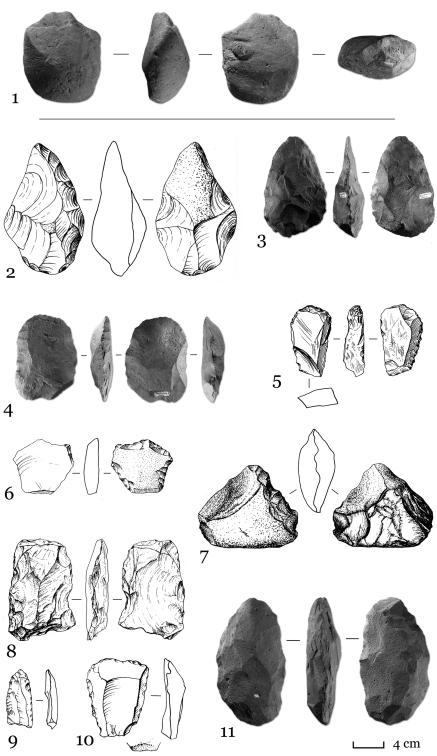
- •Preface
- •Acknowledgements
- •Introduction
- •Russian Imperial Archaeology (pre-1917)
- •Soviet Archaeology (1917–1991)
- •Marxist-Leninist Ideology
- •Intellectual Climate under Stalin
- •Post–World War II
- •‘Swings and Roundabouts’
- •Archaeology in the Caucasus since PERESTROIKA (1991–present)
- •PROBLEMS IN THE STUDY OF CAUCASIAN ARCHAEOLOGY
- •1 The Land and Its Languages
- •GEOGRAPHY AND RESOURCES
- •Physical Geography
- •Mineral Resources
- •VEGETATION AND CLIMATE
- •GEOMORPHOLOGY
- •THE LANGUAGES OF THE CAUCASUS AND DNA
- •HOMININ ARRIVALS IN THE LOWER PALAEOLITHIC
- •Characteristics of the Earliest Settlers
- •Lake Sites, Caves, and Scatters
- •Technological Trends
- •Acheulean Hand Axe Technology
- •Diet
- •Matuzka Cave and Mezmaiskaya Cave – Mousterian Sites
- •The Southern Caucasus
- •Ortvale Klde
- •Djruchula Klde
- •Other sites
- •The Demise of the Neanderthals and the End of the Middle Palaeolithic
- •NOVEL TECHNOLOGY AND NEW ARRIVALS: THE UPPER PALAEOLITHIC (35,000–10,000 BC?)
- •ROCK ART AND RITUAL
- •CONCLUSION
- •INTRODUCTION
- •THE FIRST FARMERS
- •A PRE-POTTERY NEOLITHIC?
- •Western Georgia
- •POTTERY NEOLITHIC: THE CENTRAL AND SOUTHERN CAUCASUS
- •Houses and Settlements
- •The Kura Corridor
- •The Ararat Plain
- •The Nakhichevan Region, Mil Plain, and the Mugan Steppes
- •Ditches
- •Burial and Human Body Representations
- •Materiality and Social Relations
- •Ceramic Vessels
- •Chipped and Ground Stone
- •Bone and Antler
- •Metals, Metallurgy and Other Crafts
- •THE CENTRAL AND NORTHERN CAUCASUS
- •CONTACT AND EXCHANGE: OBSIDIAN
- •Patterns of Procurement
- •CONCLUSION
- •The Pre-Maikop Horizon (ca. 4500–3800 BC)
- •The Maikop Culture
- •Distribution and Main Characteristics
- •The Chronology of the Maikop Culture
- •Villages and Households
- •Barrows and Burials
- •The Inequality of Maikop Society
- •Death as a Performance and the Persistence of Memory
- •The Crafts
- •THE SOUTHERN CAUCASUS
- •Ceramics and Metalwork
- •Houses and Settlements
- •The Treatment of the Dead
- •The Sioni Tradition (ca. 4800/4600–3200 BC)
- •Settlements and Subsistence
- •Sioni Cultural Tradition
- •Chipped Stone Tools and Other Technologies
- •CONCLUSIONS
- •BORDERS AND FRONTIERS
- •Georgia
- •Armenia
- •Azerbaijan
- •Eastern Anatolia
- •Iran
- •Amuq Plain and the Levantine Coastal Region
- •Cyprus
- •Early Settlements: Houses, Hearths, and Pits
- •Later Settlements: Diversity in Plan and Construction
- •Freestanding Wattle-and-Daub Structures
- •Villages of Circular Structures
- •Stone and Mud-brick Rectangular Houses
- •Terraced Settlements
- •Semi-Subterranean Structures
- •Burial customs
- •Sacred Spaces
- •Structures
- •Hearths
- •Early Ceramics
- •Monochrome Ware
- •Enduring Chaff-Face Wares
- •Burnished Wares
- •LATE CERAMICS
- •The Northern (Shida Kartli) Tradition
- •The Central (Tsalka) Tradition
- •The Southern (Armenian) Tradition
- •MINING FOR METAL AND ORE
- •STONE AND BONE TOOLS AND METALWORK
- •Trace Element Analyses
- •SALT AND SALT MINING
- •THE PROCESS OF MIGRATION
- •The Mobile and the Settled – The Economy of the Kura-Araxes
- •Animal Husbandry
- •Agricultural Practices
- •CONCLUSION
- •FUNERARY CUSTOMS AND BURIAL GOODS
- •MONUMENTALISM AND ITS MEANING IN THE WESTERN CAUCASUS
- •CHRONOLOGICAL DEVELOPMENTS
- •THE NATURE OF THE EVIDENCE
- •THE SOUTHERN CAUCASUS
- •EARLY BRONZE AGE IV/MIDDLE BRONZE AGE I (2500–2000 BC)
- •Sachkhere: A Bridging Site
- •Martkopi and Early Trialeti Barrows
- •Bedeni Barrows
- •Ananauri Barrow 3
- •Bedeni Barrows
- •Other Bedeni Barrows
- •Bedeni Settlements
- •Berikldeebi Village
- •Berikldeebi Pits
- •Other Bedeni Villages
- •Crafts and Technology
- •Ceramics
- •Woodworking
- •Flaked stone
- •Sacred Spaces
- •The Economic Subsistence
- •The Trialeti Complex (The Developed Stage)
- •Categorisation
- •Mound Types
- •Burial Customs and Tomb Architecture
- •Ritual Roads
- •Human Skeletal Material
- •The Zurtaketi Barrows
- •The Meskheti Barrows
- •The Atsquri Barrow
- •Ephemeral Settlements
- •Gold and Silver, Stone, and Clay
- •Silver Goblets: The Narratives
- •Silver Goblets: Interpretations
- •More Metal Containers
- •Gold Work
- •Tools and Weapons
- •Burial Ceramics
- •Settlement Ceramics
- •The Brili Cemetery
- •WAGONS AND CARTS
- •Origins and Distribution
- •The Caucasian Evidence
- •Late Bronze Age Vehicles
- •Burials and Animal Remains
- •THE MIDDLE BRONZE AGE III (CA. 1700–1450 BC)
- •The Karmirberd (Tazakend) Horizon
- •Sevan-Uzerlik Horizon
- •The Kizyl Vank Horizon
- •Apsheron Peninsula
- •THE NORTHERN CAUCASUS
- •The North Caucasian Culture
- •Catacomb Tombs
- •Stone Cist Tombs
- •Wooden Graves
- •CONCLUSIONS
- •THE CAUCASUS FROM 1500 TO 800 BC
- •Fortresses
- •Settlements
- •Burial Customs
- •Metalwork
- •Ceramics
- •Sacred Spaces
- •Menhirs
- •SAMTAVRO AND SHIDA KARTLI
- •Burial Types
- •Settlements
- •THE TALISH TRADITION
- •CONCLUSION
- •KOBAN AND COLCHIAN: ONE OR TWO TRADITIONS?
- •KOBAN: ITS PERIODISATION AND CONNECTIONS
- •SETTLEMENTS
- •Symmetrical and Linear Structures
- •TOMB TYPES AND BURIAL GROUNDS
- •THE KOBAN BURIAL GROUND
- •COSTUMES AND RANK
- •WARRIOR SYMBOLS
- •TLI AND THE CENTRAL REGION
- •WHY METALS MATTERED
- •KOBAN METALWORK
- •Jewellery and Costume Accessories
- •METAL VESSELS
- •CERAMICS
- •CONCLUSION
- •10 A World Apart: The Colchian Culture
- •SETTLEMENTS, DITCHES, AND CANALS
- •Pichori
- •HOARDS AND THE DESTRUCTION OF WEALTH
- •CERAMIC PRODUCTION
- •Tin in the Caucasus?
- •The Rise of Iron
- •Copper-Smelting through Iron Production
- •CONCLUSION
- •11 The Grand Challenges for the Archaeology of the Caucasus
- •References
- •Index
Hominin Arrivals in the Lower Palaeolithic |
41 |
Morgan, identified a workshop at the former, but the unsystematic removal of finished formal tools makes it difficult to estimate how long the site was used. Dacite and basalt were also used to manufacture tools.
A cluster of sites is also located in the lower Debed River Basin,in the northeast corner, where a tool industry of pebbles and irregular, thick fl akes, quite possibly pre-Acheulean, fashioned from a variety of raw materials – quartzite, limestone, felzite tuff, dacite, and andesite-dacite cores – have come to light (Figure 2.3). Another large collection of stone tools (some 5,500 pieces) was recovered from Mushakan-1, an open-air site near Erevan.According to Boris Gasparyan, about 8 per cent of the findings are Lower Palaeolithic in date, judging by their morphology. Given the density and scatter of worked stone across an area of 1.5 ha, Mushakan-1 was probably a workshop servicing local sites in the Ararat Depression.
Technological Trends
The ability to shape stone is a uniquely human trait that has defined humans as habitual toolmakers. Stone tools, no matter how rudimentary, inform not only on changing technological developments, but also by implication on the learned and shared behaviour that enables humans to adapt to their environment. Tools are often found in discrete concentrations, often in association with animal bones, which suggest campsites or even small shelters.Two lithic traditions distinguish the Lower Palaeolithic of the Caucasus: pebble choppers and fl akes, and Acheulean bifaces.
Oldowan Technology at Dmanisi (Georgia)
Amongst the fragmentary evidence left by these pioneers are fl akes and fl aked pebbles, with a scatter of cores and choppers (Figure 2.2). This was a basic yet versatile toolkit, capable of slitting hides of animals, dismembering carcasses, and whittling wood into tools. It is to be distinguished from Acheulean hand axes, none of which have been recovered at the site.Their absence could mean, as the excavators argue, that the Dmanisi lithic complex belonged to the pre-Acheulean assemblages of East Africa.14 Others point out that even after Acheulean hand axes were first struck in Africa about 1.7–1.6 million years ago, not all sites in Africa and Europe contained hand axes, for reasons that are still not clear.15 These sites generally lie north of the ‘Movius Line’, which divided the occupied areas of the Old World ca. 1.7 million to 400,000 years ago into three distinct geographical regions based on stone tools.16 The Caucasus is at the boundary between the Acheulean tradition found in Africa, the Near
14Vekua et al. 2006; Ferring et al. 2011.
15Klein 2005: 104.
16Sagona and Zimansky 2009: fig. 2.4.

Figure 2.3. Lower Palaeolithic stone bifaces and fl ake tools: (2, 9, 10) from Azych VI; (6) Azych V; (5, 7, 8) Kudaro; (1, 3, 4, 11) from Armenian sites (after Ljubin and Bosinski 1995; B. Gasparyan 2010).
42

The Evolution of Stone Tool Technology |
43 |
East, and central and Western Europe and various non-Acheulean traditions represented in south-eastern Europe and Eurasia. No patterning in typology or technology is apparent in the Dmanisi lithic industries as a whole.There are no bifaces or developed Oldowan artefacts, and no refits of fl akes or tools were observed. Most of the stone tools have sharp edges, suggesting that they were fashioned and used at the site. In terms of basic knapping technique, Dmanisi lithics belong to the Oldowan (Mode 1) industry.
THE EVOLUTION OF STONE TOOL TECHNOLOGY
More than forty-five years ago, Grahame Clark proposed a relative sequence of five dominant stone technologies spanning the Lower Palaeolithic through Mesolithic.17 These five ‘modes’ were not envisioned as universal, nor synchronous. Instead, they were intended to demonstrate the progression of preponderant knapping techniques from core tools to microliths using simple terminology – Modes 1 to 5. Archaeologists have generally embraced the scheme, which has the following characteristics:
Mode 1: The Oldowan Industry, the earliest used by genus Homo, was fashioned from river pebbles from which conchoidal fl akes were struck off one side using a hammerstone. The result was a core tool with a sharp edge and a blunt back where it was gripped.These tools belong to the Lower Palaeolithic and the earliest date ascribed to them is 2.6 million years ago.
Mode 2: The Acheulean Industry has more complex bifacial tools, the most prominent of which is the multi-purpose hand axe, which required a preconceived mental template of the end product.The first stage was to strike off large fl akes from an even larger core.Then the fl ake would be roughly shaped into an ovoid, pear-shaped, pointed or similar form using a hammerstone. Finally, the knapper would have used a more resilient hammer to retouch the tool all over, eventually producing two convex surfaces intersecting in a sharp edge. Acheulean tools first appeared around 1.7 million years ago in Kenya and South Africa.
Mode 3: The Mousterian Industry involves several stages (façonnage) in the preparation of the core.This technique, known as Levallois, is hierarchical in its strategy: mass of stone-prepared core-detached and desired fl ake. As such, the technique created a considerable amount of waste as well as the preconceived fl ake detached from a striking platform. This assemblage, generally associated with the Neanderthals and the Middle Palaeolithic, represents a shift in manufacture, as well as in the conceptualisation of the end product.
17 Clarke 1969: 31. For specialist outlines see, Boëda 1995;Toth and Schick 2009.

44 |
Trailblazers |
Mode 4:The Aurignacian Industry is a toolkit of blades, the fourth technological mode. Blades are long, fl at and narrow fl akes that are struck off a prepared core using a punch and a hammer.The use of two tools simultaneously to produce a desired stone tool represents yet another forward step in cognition.The advantage of blades over amorphous fl akes is the length of their cutting edge and their adaptability to specialised functions. Blade tools dominated the Upper Palaeolithic, though occasional examples are found in Middle Palaeolithic levels.
Mode 5:The Microlithic Industry characterised the later Upper Palaeolithic and Mesolithic. It comprised small stone tools about 1–5 cm in length that were used in composite tools, either attached obliquely to bone points or as projectile points in their own right. Microliths were either fashioned like blades from a very small core or snapped off a larger blade using a microburin.
Acheulean Hand Axe Technology
The Dmanisi toolmakers had certainly mastered the mechanics of stone-flaking. Their sharp-edged flakes were more than adequate to scrape bones and slice through flesh.At the same time, they appear to have had little interest in shaping the core from which the flakes were detached. Removing the entire cortex from a pebble and producing a new tool with a sharp edge around the periphery, for instance, did not matter to them.This novel idea defines the next stage of prehistory and is represented by Acheulean bifaces.A glimpse of the transition between the ‘pebble culture’ and the Acheulean is possibly afforded at Azykh, though some researchers doubt whether the pebbles found in LayersVII–X were modified by hominins.18 In any case, the apparent trend is concomitant with a change in environment from deciduous forest to birch-dominated landscape.
These distinctive oval and pear-shaped hand axes, literally the cutting edge of technology for well more than 1 million years, are the most important stone industry of the Lower Palaeolithic. They are common in the southern Caucasus, especially along the Lesser Caucasus Mountains (the Dzhavakheti Plateau and northern Armenia), where they are found at scores of Palaeolithic surface sites (Figure 2.3). South Ossetia is also rich in biface tools.That these Ossetian tools are manufactured from andesite, not locally available, suggests a procurement system extended into regions further south.There are noticeably fewer Acheulean hand axes around the Black Sea region, Imereti and the Kuban, where the tools of the Lower Palaeolithic are mostly pebble choppers. Exploratory investigations at the Akhshtyrskaia Caves, near Sochi, the first cave sites to be discovered and partially excavated, were followed by more
18 Ljubin and Bosinski 1995: 220. Acheulean tools were found in Layer V (Middle Acheulean) and LayerVI (Early Acheulean).
